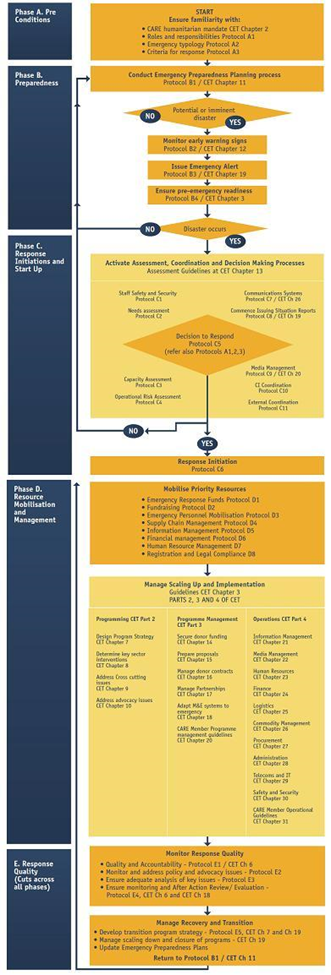5. What to do after the first 72 hours
It could now be time to quickly increase the CO’s capacity and scale up the response. A CO’s operations can become 10 times bigger in the first weeks of an emergency depending on the size and speed of the emergency..
Accountability
- Check that the response complies with CARE’s Humanitarian Accountability Framework. and the CHS
- Pay close attention to communication with beneficiaries. Seek their views in the first place, share our plans with then in return and accept their feedback.
- Check that the response complies with the conflict sensitivity checklist for rapid onset emergencies.
Humanitarian policy
- Note any civil-military issues.
- Note any threats to humanitarian space and core humanitarian principles eg impartiality.
- Act to prevent sexual exploitation and abuse – raise awareness of staff and partners.
- Consider the different needs of women, men, boys and girls.
Programme response
- Examine the main needs and any gaps in the response so far. Look at:
- how you are responding in CARE’s key sectors (food security, shelter, WASH, SRH)
- what sectors you should focus on (assessment needs, partner capacity, CARE capacity, EPP)
- how to build on current CO expertise
- how you are coordinating with clusters.
- Consider cross-cutting issues, especially:
- needs and rights of women and girls and of other vulnerable groups
- disaster risk reduction
- environment.
- Work out what extra funds and technical expertise you need.
- What are the key advocacy issues?
- Update the emergency strategy based on the latest assessments.
- Start planning for the change from emergency response to long-term recovery.
Scaling up capacity
see also ‘Tips for scaling up’ at section 7.
- Fundraise from donor groups, the UN and the public.
- Have proposal writers in the CO so that you can get proposals reflecting the real situation on the ground to donors as soon as possible.
- Set up a system for managing contracts. Each large contract will need their own project manager – also key to have a point person for each contract..
- Ensure to consider how to best ensure geography and or sectors are shared among donors to make management oversight of each contract as efficient as possible.
- Build good relationships with partners. This includes supporting their capacity and designing approaches and proposals with them. Ensure they are aware of CARE’s gender in emergency approach.
- Start M&E as soon as possible-recording numbers of beneficiaries (broken down by sex and age), amounts distributed etc.
- Plan and budget for an after action review to be done three months after the emergency. For a type 2 or 4 emergency you will need an independent evaluation (ie from outside CARE) as well as an AAR.
- Plan ahead for scaling down and closing the response or moving to longer-term development programming.
Scaling up support
Scale up all CO operational capacity at the same time as programme expansion. To avoid delays, you will need more staff and faster/better systems for:
- HR
- Hiring new staff
- Orientation of new staff
- PSEA training.
- Internal TDYs to support emergency programming
- Working with CEG and your Lead Member on international deployments.(and remember to start planning for the second wave as early as possible).
- Finance:
- allocating and tracking emergency funds/contracts
- budgets preparation and reporting
- donor and audit rules
- master budget
- storage, inventory and transport
- CIKS (if applicable)
- distribution
- procurement:
- purchasing relief supplies and equipment
- donor rules
- customs
- administration:
- travel and transport
- government regulations
- office services
- Support for new staff / accommodation, pickup etc.
- telecommunications
- phone, radio, satellite and internet
- safety and security.
- Ensure protocols are in place, update as required depending on changed situation.
Communication
Communication can be confusing, as many different parts of CARE will give support and need information. Make sure you know who you need to communicate with on key matters.
- High-level decisions: Country Director talks to CCG (Line Manager, Lead Member Emergency Director and CI Humanitarian Director, Head of Emergency Operations and the REC)
- Information management (sitreps etc.): Lead Member emergency unit and CEG (emergencyoperations@careinternational.org).
- Media: Lead Member media manager (who will talk to CI Media and Communications Coordinator/COMWG).
- HR: CI HR coordinator (emergencyHR@careinternational.org)
- If in doubt about who to contact: CI Head of Emergency Operations will refer you to the right person (emergencyoperations@careinternational.org)
Reports to send to CI
Immediately
- Emergency alert.
- Latest EPP
- Gender in Brief.
Within 24-72 hours
- Capacity assessment.
- Regular sitreps.
- ERF Proposal / budget if required (can be used as generic proposal).
- Photos and information for media.
- Initial response strategy.
- Key messages on advocacy issues.
As needed
- Assessment reports.
- Funding proposals.
- Human interest stories.
- Reports for donors.
Responding to an emergency using CARE’s protocols and guidelines

Notes:
This chart refers to chapters in the CET.
The phases often overlap. E.g. you can start phase D before the assessment is finished.



